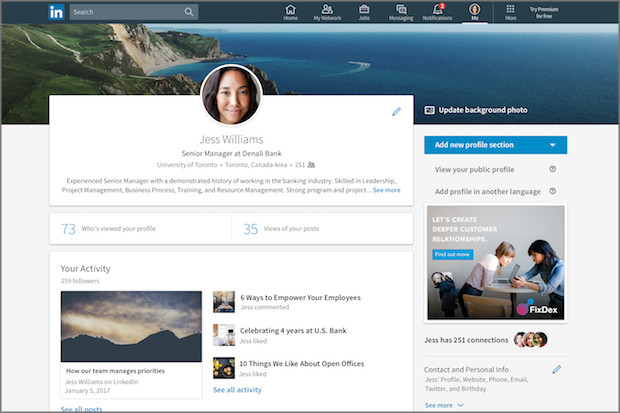As students prepare for the world of work, I mandate that my Reporting II students have a LinkedIn profile. Why?
Well, let's start with the fact that this is a network that’s now home to 500 million users in over 200 countries around the world.
More importantly, I believe the site is a great research tool. I’m not convinced it’s a great place to find — and apply — for jobs (that should only be part of your job search, not the be all — and end all). But it’s an incredibly valuable repository for networking, job seeking and researching interesting people (and their career paths).
If I’m interviewing someone, this is one of the first places I look when I’m researching them. I’d expect employers to do the same. Therefore, if you’re graduating anytime soon, then you should make sure you have a presence in this space. And if you’re interviewing for a job, ALWAYS look up the company, and the people who are interviewing you on LinkedIn first. It can yield some interesting tidbits.
For those starting out, and setting up their profile for the first time, here’s my top 10 tips to get you started:
1. Always use a professional headshot. Always. No excuses. Unless you’re applying for a job as a lifeguard, this is not the place to see you in your swimming gear.
2. Consider your personal description: do you include your job title, or — and perhaps more appropriate if you’re a job hunter — a description of what you’re looking for, or a one sentence description that says who you are? Look around the site for examples of these different approaches, and to help you determine what’s best for you.
3. Personalise your URL: don’t just go with the default address that you get given on sign-up. This approach is more professional and SEO friendly (it may come up when I Google you). Include the URL on your resume.
4. Your personal profile should read the same as your profile on your website. Be consistent! Don’t project a different version of yourself.
5. Employment history: by all means include a description of what you did, but I’m most interested in impact. What did you achieve?
6. Include clips. Import media material — and link to it on external sites — to add depth/color to your profile and your role history.
7. Get recommendations. Ask former colleagues, bosses and professors and add them to your profile. They can be super-insightful, by telling me more about you, but don’t collect them for the sake of them!
8. Don’t overlook skills. Languages, software, add this to relevant sections. I find students undersell these abilities, all the time.
9. Link to your other sites online. Make it easy for me to find your portfolio, Twitter etc. If I have to Google this, you may already have lost me.
10. Look at other people’s pages for inspiration. And to crib good ideas and language, nevermind ascertain interesting people you might want to reach out to, or follow on other social channels. LinkedIn is a fantastic repository for finding fascinating people — and companies — you might otherwise not necessarily stumble across.
Damian Radcliffe is the Carolyn S. Chambers Professor in Journalism at the University of Oregon. He is an experienced digital analyst, consultant, journalist, and researcher who has worked in editorial, research, teaching, and policy positions for the past two decades in the UK, Middle East, and USA. You can, of course, find him on LinkedIn.
This article was originally published on Medium and is republished here with permission.
Free daily newsletter
If you like our news and feature articles, you can sign up to receive our free daily (Mon-Fri) email newsletter (mobile friendly).
Related articles
- LinkedIn newsletters: are they what they are cracked up to be?
- Six self-care tips for journalists to stay sane during the general election
- RISJ Digital News Report 2024: Three essential points for your newsroom
- Seven tips for using LinkedIn as a freelance journalist
- Journalists are happy to be disconnecting from platforms, should news organisations be worried?










